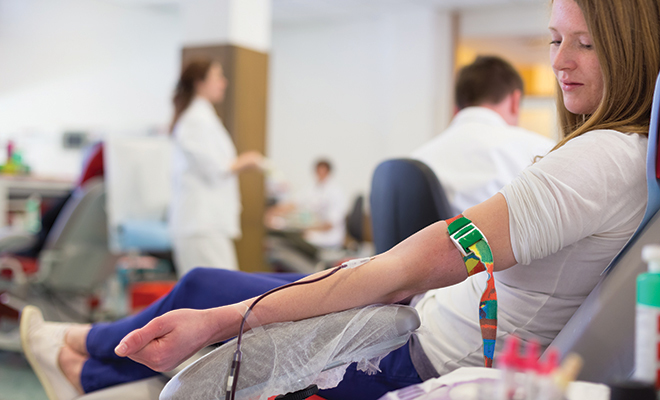
Giving of yourself: being a blood, plasma or stem cell donor
When it comes to donating, the giving of anything from our own body is personal. Whether the donation is something as simple as blood or more involved like plasma or stem cell donation, a recipient is generally granted better or sustained health through another person’s sacrifice.
Although we may become motivated to donate, the idea of giving of your own body can be scary and often confusing. So to gain a better understanding, let’s roll up our sleeves and get down to the blood-bestowing basics.
Blood donor
Of all the ways we can save or change a life, donating blood is one of the simplest and least time-consuming. Typically, from start to finish, donating blood takes about an hour and 15 minutes. Fortunately for those who are a little nervous about the procedure, the actual time from when the needle is inserted until it is removed is somewhere between eight and ten minutes.
The benefits of donating blood are boundless. Not only are donors saving lives, but they are improving their own health as well. Regular blood donations reduce the risk of certain cancers and heart disease. High levels of iron have been known to cause cancer, so donation of blood on a regular basis may keep iron levels in the body stable. Excessive iron buildup can result in oxidative damage, which may cause accelerated aging, heart attacks and strokes. And as if that isn’t enough to get you to the blood drive, a one-time blood donation helps shed about 650 calories!
Plasma donor
Plasma donation is performed less frequently than giving blood but is just as important. Plasma donation differs from blood donation in that the blood is taken from the body, plasma is separated from it and the blood is then returned to the body. The plasma is the clear, straw-colored liquid portion of blood that remains after red blood cells, white blood cells, platelets and other cellular components are removed. Plasma is usually given to patients who suffer from leukemia, have had organ transplants or are burn victims.
The procedure for plasma donation takes a little more than an hour. The discomfort involved is similar to that of blood donation and is often minimal. Although researchers don’t understand why, people who donate plasma regularly have a lower risk of developing conditions such as cardiovascular disease later in life. Other benefits include the general safety of the procedure and the satisfaction of helping someone in need.
Stem cell donor
Peripheral blood stem cell donation is a way to collect blood-forming cells for transplantation. The same blood-forming cells (sometimes called blood stem cells) that can be donated from the bone marrow are also found in the circulating blood.
The PBSC procedure is more in-depth than donating blood or plasma. To ensure safety for both donor and recipient, potential donors complete an intricate questionnaire and are personally interviewed to make sure they are healthy enough to donate and don’t pose a risk of infection to the recipient. A simple blood test is done to learn the potential donor’s human leucocyte antigen, or HLA, type, which identifies their unique tissue, in addition to completion of a basic physical.
People generally volunteer to donate stem cells because they have a loved one or friend who needs a match or because they want to help those in need. Some people give stem cells so they can get them back later if they become sick.
A typical time commitment for the donation process is 20 to 30 hours of time spread out over a four-to-six-week period. An injection of the drug filgrastim is given to patients for five days up to the procedure to increase the number of blood-forming cells in the bloodstream. On the day of the donation, blood is removed through a needle in one arm and passed through a machine that collects only the blood-forming cells. The remaining blood is returned to the body in the other arm. Travel may be required to a donation center; the National Marrow Donor Program through Be The Match covers all travel expenses, medical and non-medical expenses for donors.
Saving lives
Only a small number of people living in the U.S. who are eligible to donate blood, plasma or stem cells actually donate. Often, people are unsure of what the process entails, so they decide against giving.
The need for lifesaving donations is constant and important for a healthy and consistent blood and stem cell supply. By educating ourselves on all forms of donation, we can possibly contribute a life-saving miracle to someone in need. And donors can feel good knowing they’ve helped change or even save a life. HLM
Sources: cancer.org, rasmussen.edu, redcrossblood.org and bethematch.org.







